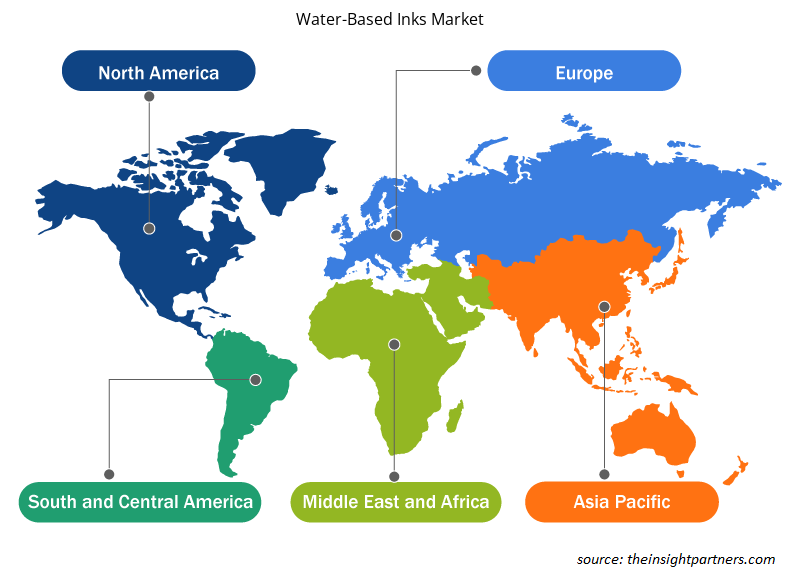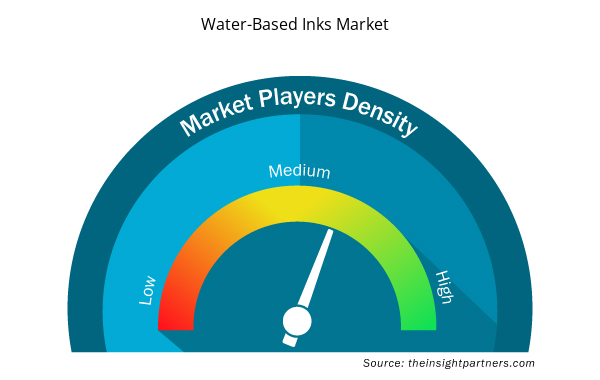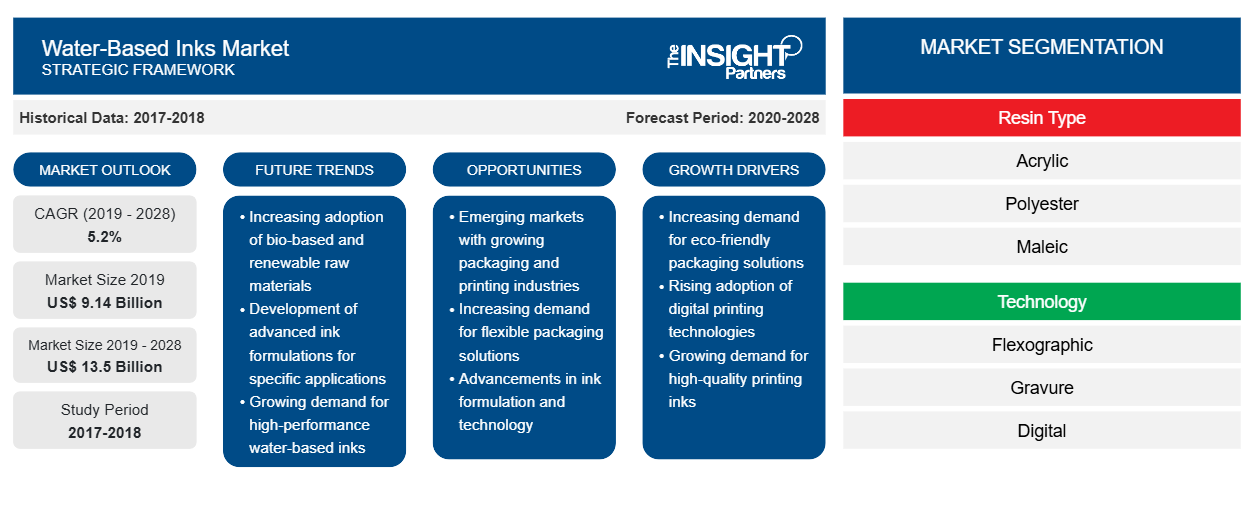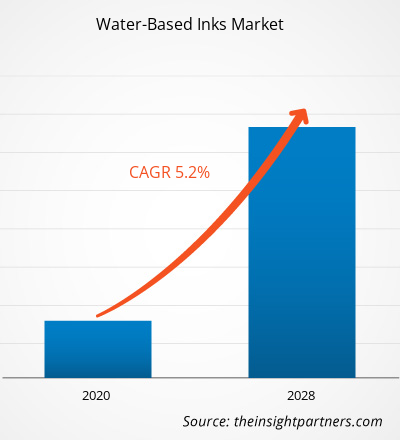水性インク市場は2019年に91億4,120万米ドルと評価され、2028年までに134億9,639万米ドルに達すると予測されており、2020年から2028年にかけて5.2%のCAGRで成長すると予想されています。
水性インクには、コロイド懸濁液に水が溶媒として含まれた顔料または染料が含まれています。水性インクの製造に使用される主な溶媒は水ですが、布地のインク膜を硬化させるのに必要な時間と熱を減らすために、インクに他の共溶媒を含めることができます。水性インクは、水がゆっくりと蒸発するため、印刷時の粘度安定性が高くなります。環境と安全に対する懸念の高まり、フレキシブル包装の増加、スクリーン印刷での利用の増加により、水性インクの需要は増加しています。
2019年、アジア太平洋地域は世界の水性インク市場で最大のシェアを占めました。この地域の水性インク市場の成長は、主に中国やインドなどの発展途上国からの需要の増加によるものです。これらの国々は、印刷および包装業界で驚異的な成長を遂げています。食品・飲料、医薬品、パーソナルケア業界の継続的な成長により、高品質の包装およびラベリング製品が求められています。水性印刷インクは、紙や厚紙の印刷に最適なインクシステムです。紙や厚紙などの吸収性基材への印刷では、他の印刷インクに比べて光沢と色が良く、表面の外観も良好で、印刷速度も遅いです。水性インクは揮発性有機化合物(VOC)の排出量がはるかに少ないため、溶剤系インクに比べて汚染排出に関連するコストがはるかに少なくなります。これらの利点により、アジア太平洋地域では水性インクの採用が増加しています。これに加えて、水性インクは布地の奥深くまで浸透し、より鮮明でシャープなエッジを持つ、完璧なディテールの長持ちするプリントを作成できます。これにはハーフトーンなどが含まれるため、複雑で詳細なデザインを印刷するのに最適です。アジア太平洋地域でのテキスタイル印刷における水性インクの需要の高まりは、予測期間中に水性インクの需要を促進すると予想されます。
進行中のCOVID-19パンデミックは、水性インク業界の成長状況を劇的に変えました。この流行により、国内外の国境が突然閉鎖されたため、業務効率が歪められ、バリューチェーンが混乱し、収益の損失と損害が発生しました。混乱したバリューチェーンは、原材料の供給に悪影響を及ぼしました。しかし、経済が事業の復活を計画しているため、今後数か月で水性インクの需要が世界的に高まると予想されています。ジャストインタイム生産への重点は、水性インク市場の成長を妨げるもう1つの要因です。パンデミック後の時代には、持続可能性とアプリケーションの多様化の重要性が高まると予想されており、水性インクの需要は飛躍的に増加すると予想されています。包装加工協会(PMMI)などのいくつかの協会は、パンデミックが印刷および包装業界に与える影響を注意深く監視し、関係者に必要な手段を提供することに取り組んでいます。したがって、政府の積極的な取り組みに支えられ、包装業界を支援するためにこのような協会が講じる効果的な措置により、今後数年間で水性インクの需要が創出されると予想されます。さらに、先進的な製品の開発に対する有名企業による多額の投資も、市場の成長を支えるもう 1 つの要因です。
要件に合わせてレポートをカスタマイズする
このレポートの一部、国レベルの分析、Excelデータパックなど、あらゆるレポートを無料でカスタマイズできます。また、スタートアップや大学向けのお得なオファーや割引もご利用いただけます。
- このレポートの主要な市場動向を入手してください。この無料サンプルには、市場動向から見積もりや予測に至るまでのデータ分析が含まれます。
市場分析
フレキシブル包装の需要が高まる
フレキシブル包装は、非剛性構造で作られた包装または包装の一部の一種であり、さまざまな形状に簡単に成形できます。このタイプの包装により、包装された商品の輸送が容易になるほか、カスタマイズ可能なデザインと長寿命が可能になります。フレキシブル包装協会によると、フレキシブル包装は米国の包装セグメントの成長に2番目に大きく貢献していると考えられており、2018年の米国での包装市場の規模は1,700億米ドルで、米国の包装市場の約19%を占めています。フレキシブル包装に使用されるインクは、製造、包装、輸送などの段階や製品の最終使用時に、全体的なグラフィック表現を向上させ、印刷された画像の品質を維持するのに役立ちます。以前は、水性インクに関連する欠点(印刷速度の低下、水分の蒸発の遅さ、不適切な濡れメカニズム、重要な基材への印刷性の不完全さなど)のため、溶剤ベースのインクが水性インクの代わりに広く使用されていました。しかし、持続可能性への注目が高まるにつれ、水性インクの需要は絶え間なく伸びています。改良樹脂、より優れたインク配合、高性能印刷機器の導入など、印刷技術の進歩により、印刷メーカーは水性インクの欠点を克服することができました。これらの開発により、水性インクはフレキシブル包装材料に関連する性能基準を満たすことができるようになりました。Marabu は、食品・飲料業界製品や、段ボール箱、おもちゃ、デジタル印刷された壁紙などの消費財業界製品のフレキシブル包装に使用される水性インクジェット インクの製造と供給に携わっています。customizable designs and better life span. As per the Flexible Packaging Association, the flexible packaging is considered to be the second largest contributor to the growth of packaging segment in the US, as it garnered ~19% of the packaging market in the country, which was worth US$ 170 billion in US in 2018. The inks used in flexible packaging help enhance the overall graphic representation and maintain the quality of imprinted images during phases such as manufacturing, packaging, and transportation, as well as at the time of the final use of the product. Earlier, solvent-based inks were extensively in use instead of water-based inks, due to drawbacks associated with the latter, such as lower printing speeds, slower water evaporation, improper wetting mechanism, and imperfect printability on critical substrates. However, the demand for water-based inks has grown incessantly owing to increasing focus on sustainability. The advancements in printing techniques such as deployment of improved resins, better ink formulation, and high-performance printing equipment have helped printing manufacturers to overcome the drawbacks of water-based inks. These developments have enabled the water-based inks to meet the performance standards associated with flexible packaging materials. Marabu is involved in production and supply of water-based inkjet inks used in flexible packaging of the food & beverages industry products as well as the consumer goods industry products, such as cardboard boxes, toys, and digitally printed wallpapers.
樹脂タイプの洞察
樹脂の種類に基づいて、水性インク市場はアクリル、ポリエステル、マレイン酸、その他に分類されます。アクリルセグメントは、2019年に最大のシェアで市場をリードしました。水性アクリル塗料は、アクリルポリマーエマルジョンに分散された顔料粒子で構成されています。顔料は、塗料に色を与える粒状の固体です。それらは小さな粒子に粉砕され、塗料中に浮遊したままになります。これらの顔料は、有機、無機、天然、または合成のいずれかです。バインダーは、インクが乾燥した後も顔料を所定の位置に保つ物質です。maleic, and others. The acrylic segment led the market with the largest share in 2019. Water-based acrylic paint is composed of pigment particles that are dispersed in an acrylic polymer emulsion. The pigments are granular solids that provide paint its color. They are milled into tiny particles and remain suspended in the paint. These pigments can either be organic, inorganic, natural, or synthetic. The binder is a substance that keeps the pigment in place after the ink dries..
水性インク市場で活動している主要な市場プレーヤーには、DIC株式会社、フリントグループ、フーバーグループ、サカタインクス株式会社、Siegwerk Druckfarben AG & Co. KGaA、T&K TOKA株式会社、東洋インキSCホールディングス株式会社、富士フイルムホールディングス株式会社、アメリカンインクス&テクノロジー、ウィコフカラーコーポレーションなどがあります。主要な市場プレーヤーは、合併や買収、新製品の発売などの戦略を採用して、地理的プレゼンスと消費者基盤を世界的に拡大しています。 DIC Corporation; Flint Group; Hubergroup; Sakata Inx Corporation; Siegwerk Druckfarben AG & Co. KGaA; T&K TOKA Co. Ltd.; Toyo Ink SC Holdings Co., Ltd.; Fujifilm Holdings Corporation; American Inks & Technology; and Wikoff Color Corporation. Major market players are adopting strategies such as mergers and acquisitions and product launches to expand their geographical presence and consumer base globally.
レポートの注目点
- 世界の水性インク市場における進歩的な業界動向は、プレーヤーが効果的な長期戦略を策定するのに役立ちます。
- 先進国市場と発展途上国市場で採用されているビジネス成長戦略
- 2019年から2028年までの世界の水性インク市場の定量分析
- さまざまな業界における水性インクの需要の推定
- 市場の成長を予測するために業界で活動するバイヤーとサプライヤーの有効性を示すPEST分析
- 競争的な市場シナリオと水性インクの需要を理解するための最近の動向
- 水性インク市場の成長を牽引・抑制する要因と相まって、市場の動向と見通し
- 世界の水性インク市場の成長に関する商業的関心を支える戦略を理解することによる意思決定プロセス
- 市場のさまざまなノードにおける水性インクの市場規模
- 世界の水性インク市場の詳細な概要とセグメンテーション、および業界における動向
- 有望な成長機会があるさまざまな地域の水性インク市場規模
水性インク市場の地域別分析
予測期間を通じて水性インク市場に影響を与える地域的な傾向と要因は、Insight Partners のアナリストによって徹底的に説明されています。このセクションでは、北米、ヨーロッパ、アジア太平洋、中東、アフリカ、南米、中米にわたる水性インク市場のセグメントと地理についても説明します。

- 水性インク市場の地域別データを入手
水性インク市場レポートの範囲
| レポート属性 | 詳細 |
|---|---|
| 2019年の市場規模 | 91億4千万米ドル |
| 2028年までの市場規模 | 135億米ドル |
| 世界のCAGR(2019年 - 2028年) | 5.2% |
| 履歴データ | 2017-2018 |
| 予測期間 | 2020-2028 |
| 対象セグメント | 樹脂の種類別
|
| 対象地域と国 | 北米
|
| 市場リーダーと主要企業プロフィール |
|
水性インク市場のプレーヤーの密度:ビジネスダイナミクスへの影響を理解する
水性インク市場は、消費者の嗜好の変化、技術の進歩、製品の利点に対する認識の高まりなどの要因により、エンドユーザーの需要が高まり、急速に成長しています。需要が高まるにつれて、企業は提供品を拡大し、消費者のニーズを満たすために革新し、新たなトレンドを活用し、市場の成長をさらに促進しています。
市場プレーヤー密度とは、特定の市場または業界内で活動している企業または会社の分布を指します。これは、特定の市場スペースに、その規模または総市場価値と比較して、どれだけの競合相手 (市場プレーヤー) が存在するかを示します。
水性インク市場で事業を展開している主要企業は次のとおりです。
- DIC株式会社
- フリントグループ
- フーバーグループ
- サカタインクス株式会社
- Siegwerk Druckfarben AG & Co. KGaA
免責事項:上記の企業は、特定の順序でランク付けされていません。

- 水性インク市場のトップキープレーヤーの概要を入手
水性インク市場(樹脂タイプ別)
- アクリル
- ポリエステル
- マレイン酸
- その他
水性インク市場、技術別
- フレキソ印刷
- グラビア
- デジタル
- その他
水性インク市場、用途別
- パッケージ
- 出版物
- タグとラベル
- その他
企業プロフィール
- DIC株式会社
- フリントグループ
- フーバーグループ
- サカタインクス株式会社
- Siegwerk Druckfarben AG & Co. KGaA
- 株式会社T&K TOKA
- 東洋インキSCホールディングス株式会社
- 富士フイルムホールディングス株式会社
- アメリカンインクス&テクノロジー
- ウィコフカラーコーポレーション
- 過去2年間の分析、基準年、CAGRによる予測(7年間)
- PEST分析とSWOT分析
- 市場規模価値/数量 - 世界、地域、国
- 業界と競争環境
- Excel データセット



Report Coverage
Revenue forecast, Company Analysis, Industry landscape, Growth factors, and Trends

Segment Covered
This text is related
to segments covered.

Regional Scope
North America, Europe, Asia Pacific, Middle East & Africa, South & Central America

Country Scope
This text is related
to country scope.
よくある質問
Based on application, the packaging segment held the largest share in the global water-based inks market in 2019. The packaging segment comprises flexible packages, tags, corrugated containers, labels, metal cans, and folding cartons. Increasing demand for flexible packaging in the food and beverages sector due to its esthetic appeal and less weight, is expected to fuel the demand for packaging in the next few years. Water-based inks have improved flow behavior, gloss, color, good surface appearance. It improves the efficiency of packaging production, reduces wasted ink, and improves operating rates for printing equipment. Apart from this, food & beverage, and personal care companies demand for packages that adds value and marketability to their products. Thus, the demand for high-quality tags, corrugated containers, labels is increasing which further supports the growth of water-based inks market. With an increasing consumer focus on sustainability, traditional rigid packaging solutions are being replaced by innovative, eco-friendly packaging solutions. Water-based inks do not contain Volatile Organic Compounds (VOC), thus making them popular choice for packaging.
The major players operating in the global water-based inks market are DIC Corporation, Flint Group, Hubergroup, Sakata Inx Corporation, Siegwerk Druckfarben AG & Co. KGaA, T&K TOKA Co. Ltd., Toyo Ink SC Holdings Co., Ltd., Fujifilm Holdings Corporation, American Inks & Technology and Wikoff Color Corporation among many others.
In 2019, APAC contributed to the largest share in the global water-based inks market. The growth of the water-based inks market in this region is primarily attributed to the increasing demand from developing countries such as China and India. These countries are experiencing tremendous growth in printing & packaging industry. The continuous growth in food & beverage, pharma and personal care industry demands for high-quality packaging & labelling products. Water-based printing inks is an excellent ink system for paper and cardboard printing. They have better gloss, color, good surface appearance as compared to other printing inks when it comes to slower printing application and on an absorbent substrate such as paper and cardboard. Water-based ink emits much less VOCs thus, the cost related to pollution emission is much less when compared to solvent-based ink. All these advantages have increased the adoption of water-based inks in APAC region.
Trends and growth analysis reports related to Chemicals and Materials : READ MORE..
The List of Companies - Water-based Inks Market
- DIC Corporation
- Flint Group
- Hubergroup
- Sakata Inx Corporation
- Siegwerk Druckfarben AG & Co. KGaA
- T&K TOKA Co. Ltd.
- Toyo Ink SC Holdings Co., Ltd.
- Fujifilm Holdings Corporation
- American Inks & Technology
- Wikoff Color Corporation
The Insight Partners performs research in 4 major stages: Data Collection & Secondary Research, Primary Research, Data Analysis and Data Triangulation & Final Review.
- Data Collection and Secondary Research:
As a market research and consulting firm operating from a decade, we have published and advised several client across the globe. First step for any study will start with an assessment of currently available data and insights from existing reports. Further, historical and current market information is collected from Investor Presentations, Annual Reports, SEC Filings, etc., and other information related to company’s performance and market positioning are gathered from Paid Databases (Factiva, Hoovers, and Reuters) and various other publications available in public domain.
Several associations trade associates, technical forums, institutes, societies and organization are accessed to gain technical as well as market related insights through their publications such as research papers, blogs and press releases related to the studies are referred to get cues about the market. Further, white papers, journals, magazines, and other news articles published in last 3 years are scrutinized and analyzed to understand the current market trends.
- Primary Research:
The primarily interview analysis comprise of data obtained from industry participants interview and answers to survey questions gathered by in-house primary team.
For primary research, interviews are conducted with industry experts/CEOs/Marketing Managers/VPs/Subject Matter Experts from both demand and supply side to get a 360-degree view of the market. The primary team conducts several interviews based on the complexity of the markets to understand the various market trends and dynamics which makes research more credible and precise.
A typical research interview fulfils the following functions:
- Provides first-hand information on the market size, market trends, growth trends, competitive landscape, and outlook
- Validates and strengthens in-house secondary research findings
- Develops the analysis team’s expertise and market understanding
Primary research involves email interactions and telephone interviews for each market, category, segment, and sub-segment across geographies. The participants who typically take part in such a process include, but are not limited to:
- Industry participants: VPs, business development managers, market intelligence managers and national sales managers
- Outside experts: Valuation experts, research analysts and key opinion leaders specializing in the electronics and semiconductor industry.
Below is the breakup of our primary respondents by company, designation, and region:

Once we receive the confirmation from primary research sources or primary respondents, we finalize the base year market estimation and forecast the data as per the macroeconomic and microeconomic factors assessed during data collection.
- Data Analysis:
Once data is validated through both secondary as well as primary respondents, we finalize the market estimations by hypothesis formulation and factor analysis at regional and country level.
- Macro-Economic Factor Analysis:
We analyse macroeconomic indicators such the gross domestic product (GDP), increase in the demand for goods and services across industries, technological advancement, regional economic growth, governmental policies, the influence of COVID-19, PEST analysis, and other aspects. This analysis aids in setting benchmarks for various nations/regions and approximating market splits. Additionally, the general trend of the aforementioned components aid in determining the market's development possibilities.
- Country Level Data:
Various factors that are especially aligned to the country are taken into account to determine the market size for a certain area and country, including the presence of vendors, such as headquarters and offices, the country's GDP, demand patterns, and industry growth. To comprehend the market dynamics for the nation, a number of growth variables, inhibitors, application areas, and current market trends are researched. The aforementioned elements aid in determining the country's overall market's growth potential.
- Company Profile:
The “Table of Contents” is formulated by listing and analyzing more than 25 - 30 companies operating in the market ecosystem across geographies. However, we profile only 10 companies as a standard practice in our syndicate reports. These 10 companies comprise leading, emerging, and regional players. Nonetheless, our analysis is not restricted to the 10 listed companies, we also analyze other companies present in the market to develop a holistic view and understand the prevailing trends. The “Company Profiles” section in the report covers key facts, business description, products & services, financial information, SWOT analysis, and key developments. The financial information presented is extracted from the annual reports and official documents of the publicly listed companies. Upon collecting the information for the sections of respective companies, we verify them via various primary sources and then compile the data in respective company profiles. The company level information helps us in deriving the base number as well as in forecasting the market size.
- Developing Base Number:
Aggregation of sales statistics (2020-2022) and macro-economic factor, and other secondary and primary research insights are utilized to arrive at base number and related market shares for 2022. The data gaps are identified in this step and relevant market data is analyzed, collected from paid primary interviews or databases. On finalizing the base year market size, forecasts are developed on the basis of macro-economic, industry and market growth factors and company level analysis.
- Data Triangulation and Final Review:
The market findings and base year market size calculations are validated from supply as well as demand side. Demand side validations are based on macro-economic factor analysis and benchmarks for respective regions and countries. In case of supply side validations, revenues of major companies are estimated (in case not available) based on industry benchmark, approximate number of employees, product portfolio, and primary interviews revenues are gathered. Further revenue from target product/service segment is assessed to avoid overshooting of market statistics. In case of heavy deviations between supply and demand side values, all thes steps are repeated to achieve synchronization.
We follow an iterative model, wherein we share our research findings with Subject Matter Experts (SME’s) and Key Opinion Leaders (KOLs) until consensus view of the market is not formulated – this model negates any drastic deviation in the opinions of experts. Only validated and universally acceptable research findings are quoted in our reports.
We have important check points that we use to validate our research findings – which we call – data triangulation, where we validate the information, we generate from secondary sources with primary interviews and then we re-validate with our internal data bases and Subject matter experts. This comprehensive model enables us to deliver high quality, reliable data in shortest possible time.


 このレポートの無料サンプルを入手する
このレポートの無料サンプルを入手する